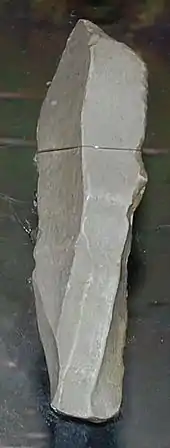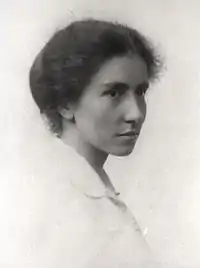Creswellian culture
The Creswellian is a British Upper Palaeolithic culture named after the type site of Creswell Crags in Derbyshire by Dorothy Garrod in 1926.[3] It is also known as the British Late Magdalenian.[4] According to Andreas Maier: "In current research, the Creswellian and Hamburgian are considered to be independent but closely related entities which are rooted in the Magdalenian."[5] The Creswellian is dated between 13,000 and 11,800 BP[1] and was followed by the most recent ice age, the Younger Dryas, when Britain was at times unoccupied by humans.[6]
 | |
| Geographical range | Great Britain |
|---|---|
| Period | Upper Paleolithic |
| Dates | between 13,000–11,800 BP[1] |
| Type site | Creswell Crags |
| Major sites | Gough's Cave, Kents Cavern |

History
The term Creswellian appeared for the first time in 1926 in Dorothy Garrod's The Upper Palaeolithic Age in Britain. This was the first academic publication[7] by the woman who became in 1939 the first woman ever elected as a professor at Cambridge.[8] It is also the first monograph about the Upper Paleolithic of Britain at the national level and it remained the only one on the subject for half a century. Garrod suggested that the British variant of the Magdalenian industry is different enough to create a specific name:[7]
"I propose tentatively "Creswellian", since Creswell Crags is the station in which it is found in greatest abundance and variety."
— Dorothy Garrod, The Upper Palaeolithic Age in Britain, Oxford, Clarendon Press, 1926, p. 194.
The definition of Creswellian was refined since then and now refers exclusively, in the British context, to the Late Magdalenian-style industry.
Description
Diagnostic tools used to identify the period include trapezoidal backed blades called Cheddar points, variant forms known as Creswell points, and smaller bladelets. Other tool types include end scrapers made from long, straight blades. A special preparation technique was employed to remove blades from a core through striking in a single direction, leaving a distinct 'spur' on the platform. The tools were made using a soft hammerstone or an antler hammer.
Other finds include Baltic amber, mammoth ivory and animal teeth and bone. These were used to make harpoons, awls, beads and needles. Unusual bevelled ivory rods, known as sagaies have been found at Gough's Cave in Somerset and Kent's Cavern in Devon.
Twenty eight sites producing Cheddar points are known in England and Wales though none have so far been found in Scotland or Ireland, regions which it is thought were not colonised by humans until later. Most sites are caves but there is increasing evidence for open air activity and that preferred sources of flint were exploited and that tools travelled distances of up to 100 miles from their sources. Some of the flint at Gough's Cave came from the Vale of Pewsey in Wiltshire whilst non-local seashells and amber from the North Sea coast also indicate a highly mobile population. This matches evidence from the Magdelanian cultures elsewhere in Europe and may suggest that exchange of goods and the sending out of specialised expeditions seeking raw materials may have been practised. Analysis of debitage at occupation sites suggests that flint nodules were reduced in size at source and the lighter blades carried by Creswellian groups as 'toolkits' in order to reduce the weight carried.
Comparison of flint from Kent's Cavern and Creswell Crags has led some archaeologists to believe that they were made by the same group.
Food species eaten by Creswellian hunters focused on the wild horse (Equus ferus) or the red deer (Cervus elaphus), probably depending on the season, although the Arctic hare, reindeer, mammoth, Saiga antelope, wild cow, brown bear, lynx, Arctic fox and wolf were also exploited.
Highly fragmentary fossil bones were found in Gough's Cave at Cheddar. They had marks that suggested actions of skinning, dismembering, defleshing and marrow extraction. The excavations of 1986-1987 noted that human and animal remains were mixed, with no particular distribution or arrangement of the human bones. They also show the signs of the same treatments as the animal bones. These findings were interpreted in the sense of a nutritional cannibalism. However, slight differences from other sites in skull treatment leave open the possibility of elements of ritual cannibalism.[9]
See also
References
- Robert Hosfield, Vanessa Straker and Paula Gardiner with contributions from Anthony Brown, Paul Davies, Ralph Fyfe, Julie Jones and Heather Tinsley (2007). "Palaeolithic and Mesolithic". In Webster, C.J. (ed.). The Archaeology of South West England. Somerset County Council. p. 36.
There are numerous radiocarbon determinations on human remains, butchered animal bones and organic artefacts which date the Creswellian to between 13,000-11.800 BP (Jacobi 2004).
CS1 maint: multiple names: authors list (link) - The museum's exhibit label says "Cresswell points were probably hafted knife blades", Derby Museum, read July 2011
- Davies, William; et al. (1999). Dorothy Garrod and the progress of the Palaeolithic: studies in the prehistoric archaeology of the Near East and Europe. Oxbow Books. p. 282.
- Pettit, Paul; White, Mark (2012). The British Palaeolithic: Human Societies at the Edge of the Pleistocene World. Abingdon, UK: Routledge. p. 440. ISBN 978-0-415-67455-3.
- Maier, Andreas (2015). The Central European Magdalenian: Regional Diversity and Internal Variability. Springer. p. 133.
- Stringer, Chris (2011). "The Changing Landscapes of the Earliest Human Occupation of Britain and Europe". In Ashton, N.; et al. (eds.). The Ancient Human Occupation of Britain. Elsevier. p. 1. ISBN 9780444535979.
- Kathryn Price « One vision, one faith, one woman: Dorothy Garrod and the Crystallisation of Prehistory », in Great Prehistorians: 150 Years of Palaeolithic Research, 1859-2009, London, Lythic Studies Society, 2009, p. 141-142.
- Pamela Jane Smith, « From ‘small, dark and alive’ to ‘cripplingly shy’: Dorothy Garrod as the first woman Professor at Cambridge » Archived 28 February 2009 at the Wayback Machine, University of Cambridge, 2005. Accessed 6 juin 2011.
- P. Andrews, Y. Fernández-Jalvo, « Cannibalism in Britain: Taphonomy of the Creswellian (Pleistocene) faunal and human remains from Gough's Cave (Somerset, England) », Bulletin of the Natural History Museum: Geology, n° 58, 2003, pp. 59-81 (doi:10.1017/S096804620300010X).
Literature
- R. N. E. Barton, R. M. Jacobi, D. Stapert, & M. J. Street (2003) The Late-glacial reoccupation of the British Isles and the Creswellian Journal of Quaternary Studies Volume 18, Issue 7 October 2003, Pp 631–643
- Lynden Cooper A Creswellian campsite, Newtown Linford Leic.Arch. Sept 2002 11/10/02 7:55 AM Page 78
- Campbell, J.B. 1977 The Upper Palaeolithic of Britain: a study of man and nature during the Late Ice Age. Oxford : Clarendon press.
- Garrod, D.A.E. 1926 The Upper Palaeolithic Age in Britain. Oxford: Clarendon Press.
- Grant M & Harding P, Farndon Fields, Nottinghamshire: in situ multi-phased Late Upper Palaeolithic activity on the floodplain
- Jacobi, R.M. 1991 The Creswellian, Creswell and Cheddar. In: Barton, N., Roberts, A.J. and Roe, D.A. (eds) The Late Glacial in north-west Europe: human adaptation and environmental change at the end of the Pleistocene. London: Council for British Archaeology Research Report 77, 128-140.
- Jenkinson R.D.S. and Gilbertson, D.D. 1984 In the Shadow of Extinction: A Quaternary Archaeology and Palaeoecology of the Lake, Fissures and Smaller Caves at Creswell Crags, S.S.S.I. Sheffield: University of Sheffield, Department of Prehistory and Archaeology.
- Ward T & Saville A ‘‘Howburn Farm: excavating Scotland's first people. Current Archaeology, Issue 243, June 2010 pp18–23.
